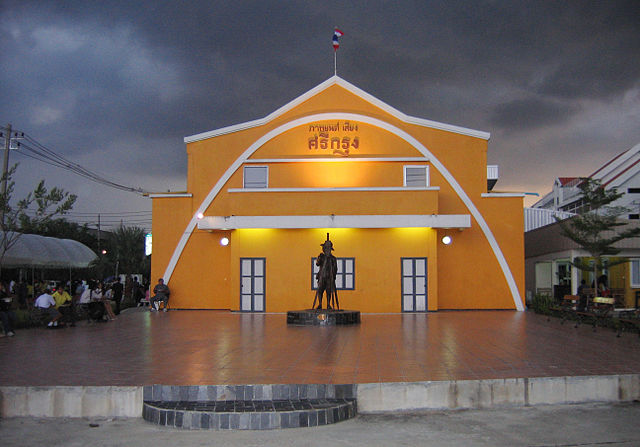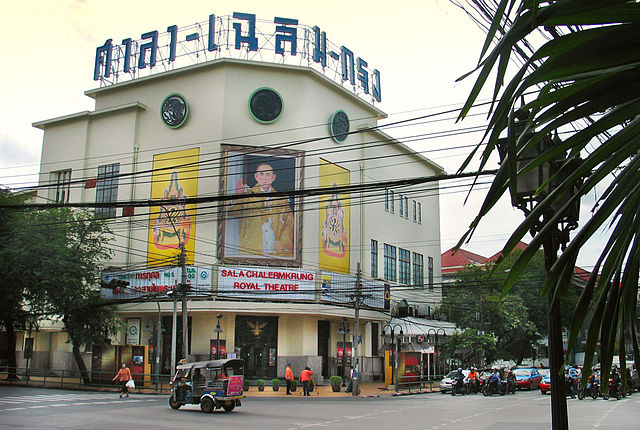
While Thamamsat University students are waiting for the always interesting film programs screened at the Rewat Buddhinan Auditorium on the Underground 2 level of the Pridi Banomyong Library, Tha Prachan campus to begin again, there are some alternatives for moviegoers.
As one news report explained, The Thai Film Archive is continually adding films to a Covid-19 playlist on their YouTube channel, which includes the feature length “Santi-Vina” (1954).
The Thammasat University Library owns an extensive collection of books on the history and art of cinema.
As its website indicates,
The Thai Film Archive was established in 1984 as the National Film Archive as a unit under the Fine Arts Department. Before then, there was no agency in charge if preserving Thailand rich cinematic legacy that dates back to the first years if motion pictures. The National Film Archive became the Film Archive (Public Organization) in 2009 after receiving status as a public organization, a higher range on the bureaucratic ladder that should enable it to more effective management.
The Film Archive (Public Organization) has the following objectives:
(1)
To acquire, collect, evaluate, select and create cataloging system for film and film related matters preserving the same for national intellectual property and national artistic and cultural heritage.
(2)
To create knowledge of conservation in order to carry out conservation operation and conservation services for films and film related matters.
(3)
To study, research and to support research concerning films and to support the use of film as research tool in other fields of knowledge.
(4)
To provide public services for the study, research and use of films including film related materials and various information available at the Film Archive.
(5)
To organize activities promoting and disseminating films as study media for artistic and cultural works and entertainment and also as sources for non-formal education, informal education, and lifelong education.
(6)
To produce film related printed media, audio-visual media, and electronic media for dissemination as film education and production to public.
(7)
To be an information center for film and also to connect film information with international film archives, educational institutes, and other film bureaus both domestic and abroad.
(8)
To be a member and participate in activities with international bureaus or organizations in connection with the affairs of the Film Archive, in this regard, as assigned by the Council of Ministers or Minister.
Film Archive (Public Organization) is the national archive for preserving films, audiovisuals, and other related subjects which aims to meet world standard, includes being the center of knowledge and serving its target users to their utmost benefits.
-Mission/Objective
1.
Seek and collect films, audiovisuals, and other related subjects to preserve as intellectual properties and national heritages.
2.
Research to build knowledge on films, audiovisuals, and other related subjects.
3.
Offer public service for education and research on films while encouraging and promoting the use of films to its utmost potential.
Among the films available for viewing on the Thai Film Archive YouTube channel is Santi-Vina.
News reports announced in 2016 the rediscovery of Santi-Vina, a long lost Thai classic film from 1954. The first Thai film to be shot in colour on 35mm, Santi-Vina was directed by Thavi Na Bangchang (or Marut) and produced by Hanuman Production. It tells the story of a blind man called Santi and his lover Vina, a fearless young woman who will do anything to defy prejudices and be with the man she loves. On 15 July 2016, the Thai Film Archive hosted a screening of Santi-Vina, the negative prints of which were thought to be lost before they were discovered at the British Film Institute in London two years before. After a lengthy restoration process at a laboratory in Italy and a world premiere at the Cannes Film Festival, Santi-Vina was finally seen again in Thailand.
Santi-Vina was also shown at SF World Cinema CentralWorld.

One reviewer from Singapore offered the opinion:
With characters speaking in clipped, measured dialogue, perhaps a hallmark of vintage cinema, director Thavi Na Bangchang, gives the audience an economical rendition of a Thai version of Romeo and Juliet. Told with simplicity and a delicately-curated montage of village rituals against the gawking at nature, graceful fields and majestic limestone cave formations, the film in its meticulously-graded form, is a quiet spectacle to behold.
However, far beyond exuding the appeal of an ornate museum relic, the film packs a subliminal Buddhist wisdom that knocks at the consciousness of the more contemporary minds that were gathered in the cinema watching it today. Running in parallel to the doomed romance between Santi and Vina is Santi’s rocky road to religious enlightenment. The film has wisely woven together seemingly disparate elements to tell a story about karma and destiny. These include Santi’s blindness, battling love rivals, the distraction of romance against peace in practising Buddhism and falling rocks in the cave where Santi lived with the abbot. Petrified at first by the sound of the falling rubble, Santi lives to accept the abbot’s explanation that this is normal and one can learn to ‘filter out’ this disturbance in his daily life. With deliberate strokes, the falling rocks are actually planted as a major plot lever which gives the audience a certain moment of epiphany towards the end…
In telling Santi’s story of a religious awakening, director Thavi artfully turns the royal flush he has in his poker deck in a subtle yet beguiling reveal. The film is delicately balanced between scenes that advance the narrative and scenes that enrich the spirituality and recapitulate an overall sense of the beauty in the laws of nature. In between family conversations and heated fights are extended takes on the gleaming Buddha statues in the cave, glorious sunsets and close-ups on the glacial sailing by of candy-hued ‘Krathongs’ (ornately-decorated offerings) during the Loy Krathong festival. The meditative is interwoven with the depictive and the real messages reside in between the lines – spoken lines and visual lines.
Watching Santi-Vina is as much a spiritual experience as it is a visually gratifying feast for lovers of the rich hues of vintage cinema… The film’s journey to restoration is in itself a cornerstone to the film’s significance and why it warrants some reverence. The restored copy was in fact assembled from recently-discovered sound negatives in the British archives and film reels from China and Russia. If the film’s approximate duration of two hours seems a sermon too long, be assured the one will emerge from it gleefully enlightened.

(All images courtesy of Wikimedia Commons)
